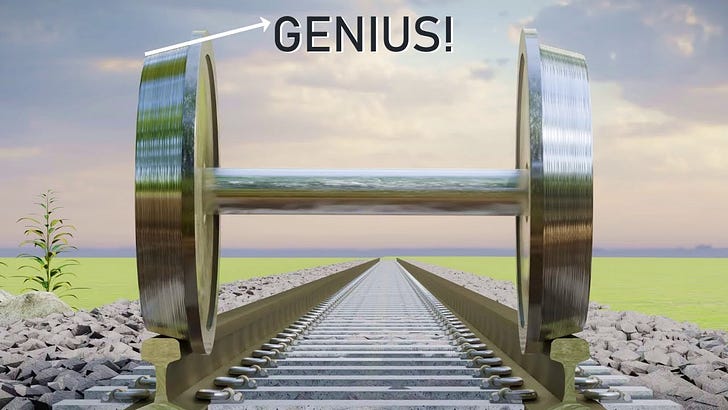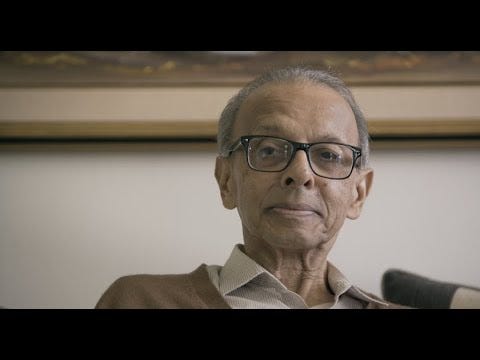We've travelled on trains so often, we hardly think of the conceptual leap it took to make it a transportation option worldwide.
Car and cycle wheels are round and we don't think much of the turning radius required to make turns.
But wheels on a train run on parallel tracks.
So, how do they handle turns?
Cars and bikes can sweep across the road but trains are restricted
Won't one of the wheels move off-track? That would be disastrous.
Pay attention to the inner extension of the wheels on both sides.
Train and track engineers have made the wheels more like cones spinning on tracks.
As the train takes a turn, the inner wheel travels less and the outer wheel moves through a larger arc.
Held by the axle in the middle which allows flexibility when the train goes around a curve.
It can't be a right angle curve - but you've seen how tracks curve through a distance of a few hundred meters to accommodate the turns.
The other marvel would have been working out how the wheels switch tracks. It would have to rise above and then slip into the junction as every set of wheels right along the train shifts effortlessly but there is a grinding noise.
And we hear it every time we travel. It's so much a part of the 'normal' train sounds, we barely register it.
The romance of train travel is legendary.
But it was created by some innovative engineers who solved the problem so well, we've never had to rethink it.
What does 100% digital transformation look like?
No paper for any process?
All work done online? These percentages are highly confusing.
And some of the reports push this even further - where CEOs say that they've transformed about 30-40% and others claim that it is 70-80%.
How do these companies look? How do they function and how are the people who manage these companies so sure about the percentages?
Is there a way to break this down into a set of processes at a company and then see how far along the line they've travelled?
Even then, the parameters would be hard to nail down. At what stage is a manufacturing company digitally transformed? When it's billing is completely online?
Or when its manufacturing process is driven by robotics? Or when the sales and marketing are only done through digital media?
You see where this is going? There is a digital component to what we do but how much of it is a transformation is hard to measure. Or even hazard a guess.
In a sense, it's like the other favorite these days - smart cities! Talk to 100 people and you'll get 120 definitions.
We've all been digitally transforming since the mainframes arrived in the 60s. Back then, it touched far fewer people and organizations.
Now, it's as if we're permanently in some kind of digital environment for a large part of our waking hours.
Is individual transformation different from the sum total of transformation at a company?
We invent these glib phrases and then fail to define it is simple and clear terms.
Why is memorabilia valuable?
The smashed cars from Mad Max Fury Road are being auctioned off shortly.
They may not look anything like the pictures shown.
But people who found the film resonated with them may want a part of the action if they can afford it.
They're great conversation pieces, for sure.
All the vehicles in the film were the products of fevered imagination - none of them very safe or even road-worthy.
But you can re-live the film sequences and show off a piece of movie history.
There's something about success that seems to spawn this feeling.
People want to be a part of grand projects that have made an impact. The costume from a blockbuster. The light saber from Star Wars.
That is when the merchandising masters realised the infinite potential for films to make money far beyond the screen. And that began a wave of everything from lines of toys, video games to all kinds of knick-knacks that generated f or decades after box office receipts.
We have this love for anything touched by greatness.
And this sense about long-lost glory as well. The ruins of the Colosseum in Rome. Or walking next to the Sphinx and the pyramids in Egypt.
Or our own Taj Mahal. A mausoleum as a labor of love. Two ironies in the same breath.
It doesn't matter if the memories are our own or something we can identify with.
Otherwise, what explains the interest in the ruins of vehicles which we can see every time we drive past automobile scrapyards?
Every week, I'll plant a few ideas in your mind on branding, behavior and markets. Triggers for your thoughts. Spread the word to your friends. All you have to do is click the link and enter an email address.












Share this post